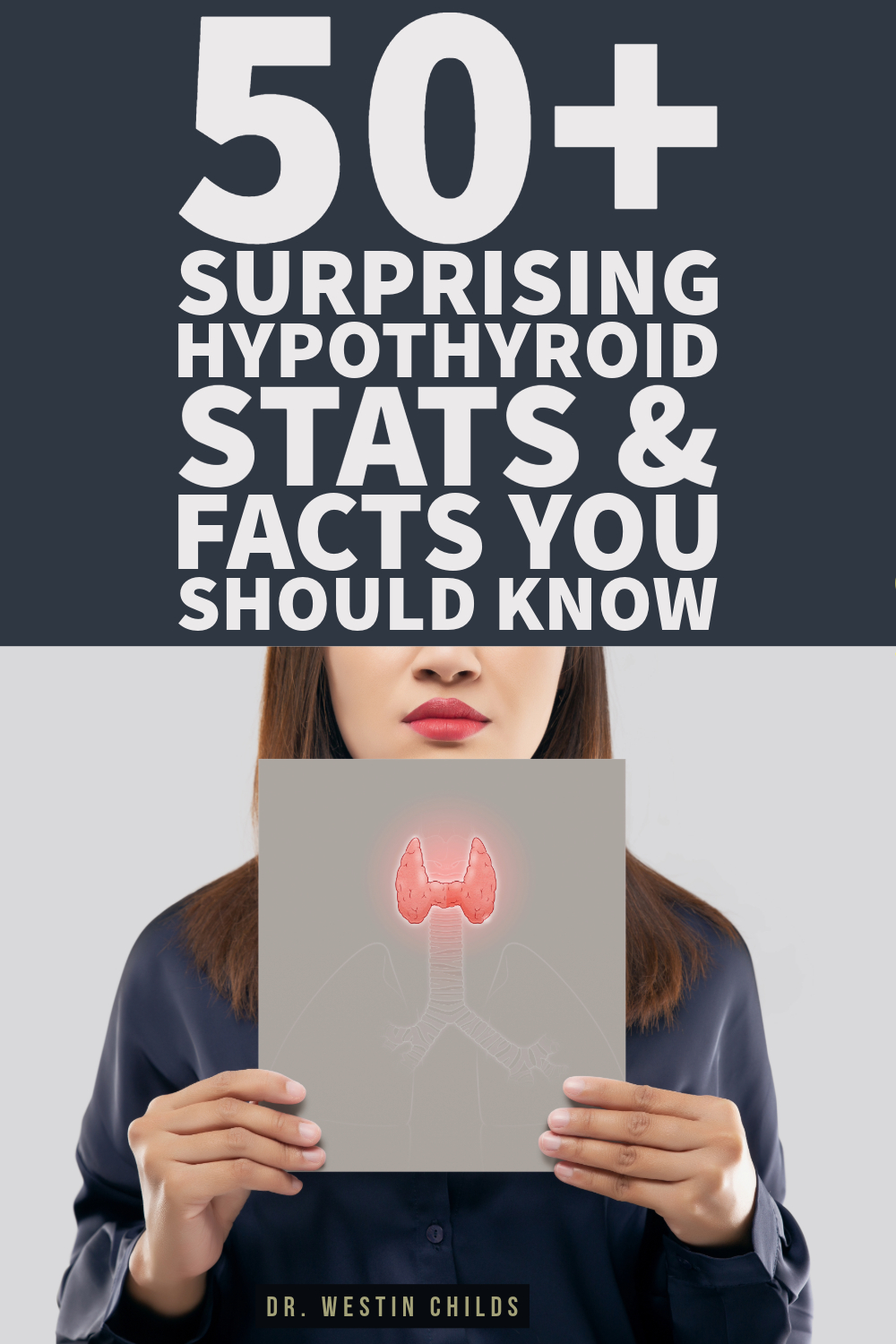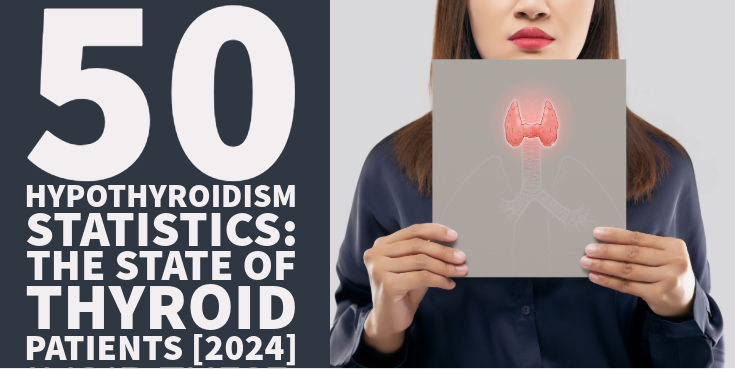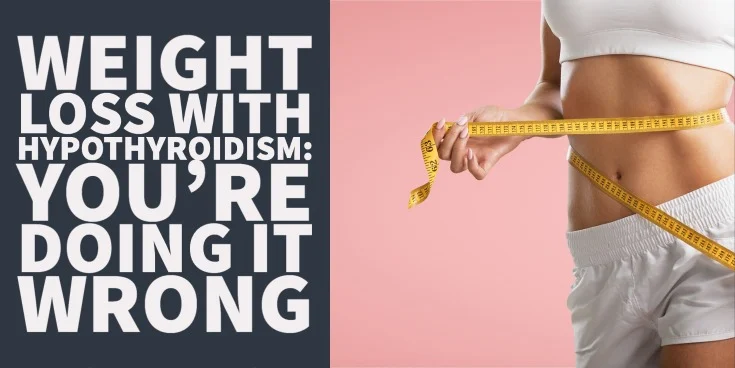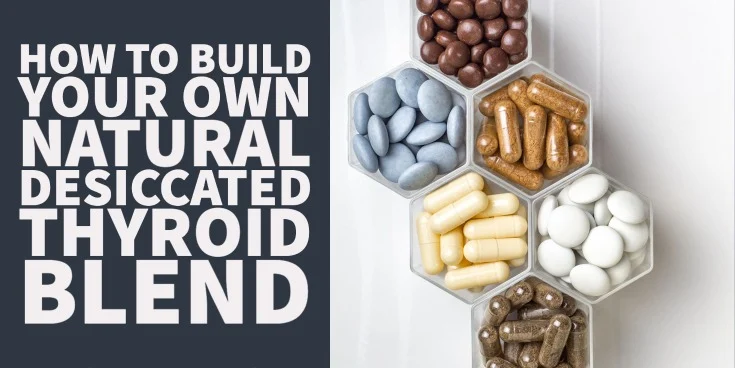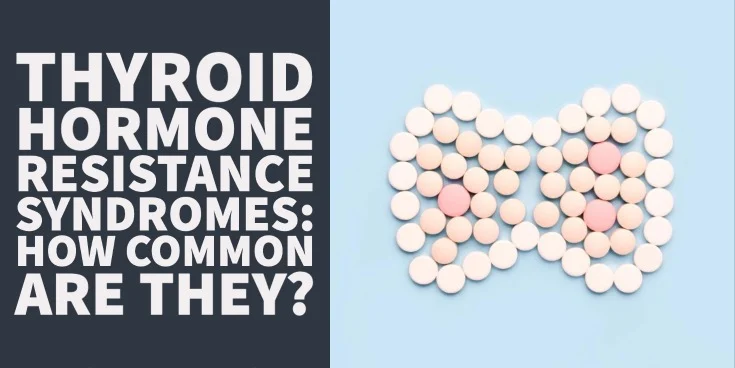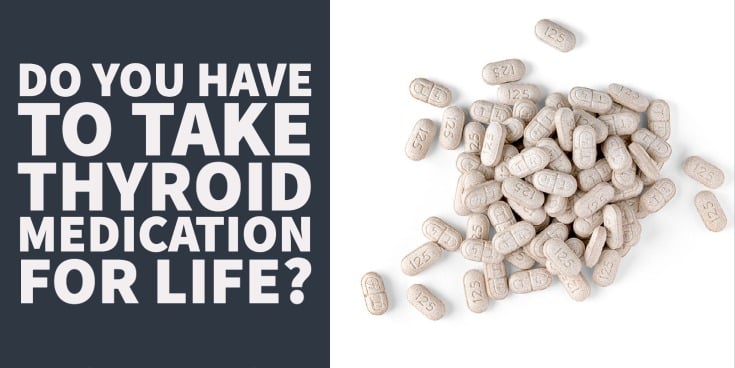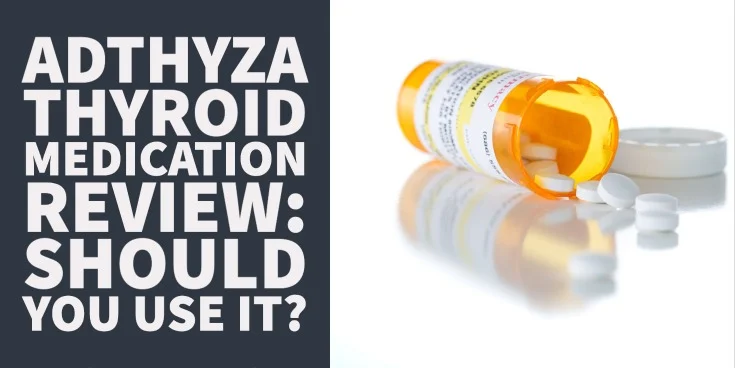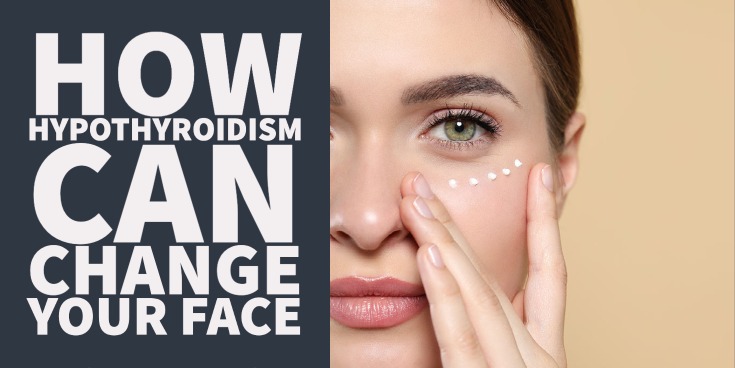Hypothyroidism is the most common endocrine disorder of the thyroid gland that impacts over 30 million Americans.
These verified statistics from research studies and third-party reliable sources shed light on this growing problem and how it impacts not only thyroid patients and physicians but the healthcare system as a whole.
Top Hypothyroid Statistics
- The prevalence of hypothyroidism grew from 9.6% of the population in 2012 to 11.7% in 2019 (1).
- Women are 5 to 9 times more likely (2) than men to have hypothyroidism.
- The cause of hypothyroidism in more than 70% of patients with hypothyroidism is Hashimoto’s thyroiditis.
- The most common prescription medication used to treat hypothyroidism is levothyroxine.
- In 2023, levothyroxine was the #1 most popular medication based on filled prescriptions (3) beating out vitamin D at #2, amoxicillin at #3, and lisinopril at #4.
- The rate of subclinical hypothyroidism (4) in the United States is 3-15%.
- The risk of subclinical hypothyroidism progressing to hypothyroidism is 2% to 6% per year (5).
- It’s estimated that 15% of women over the age of 60 years have subclinical hypothyroidism.
Monetary Impact Of Hypothyroidism On Patients
As a chronic disease, patients with hypothyroidism are required* to take thyroid medication for life which incurs a repeated monthly cost.
*as you will see, some statistics do not support this claim but it is, nonetheless, the current recommendation for treatment.
On top of medication costs, hypothyroid patients also suffer from downstream effects related to thyroid dysfunction (6) that increase their risk of developing other medical conditions which incur added costs.
Direct costs related to thyroid medication include:
- $460 and $2,555 per year (7), depending on the medication prescribed.
Indirect costs associated with the hypothyroid state include:
- High cholesterol: Cholesterol-lowering medications cost as much as $2,177 per year depending on the medication prescribed.
- Fatigue: Fatigue costs patients up to $3,000 per year (8) due to missed work.
- Weight gain: Obesity-related treatments cost up to $4,789 yearly for women and $2,646 yearly for men (9).
- Hair loss: Hair loss treatments range from $20 per month up to thousands for more advanced therapies such as PRP, hair transplant, and low-level laser therapy.
- Depression: Depression is estimated to cost up to $2,717 each year, mostly related to the price of anti-depressant medications.
Statistics of note regarding the presence of these conditions among hypothyroid patients:
- 30% of hypothyroid patients have increased total cholesterol (10) and 90% have dyslipidemia
- One-third of patients with hypothyroidism (11) present with fatigue
- 69% of thyroid patients self-report weight management issues (12)
- 33% of hypothyroid patients experience hair loss (13)
- 40% of hypothyroid patients develop clinically significant depression (14)
It is thought that the burden of these indirect hypothyroid-related conditions may be the source of significant stress and dissatisfaction among this patient population.
Causes of Hypothyroidism
Hypothyroidism emerges from dysfunction in one of three places:
- The thyroid gland directly
- The pituitary
- The hypothalamus
By far, the most common cause of hypothyroidism in developed countries is the autoimmune disease Hashimoto’s thyroiditis which results in direct damage to the thyroid gland.
- Current estimates suggest that up to 70% of patients with hypothyroidism have chronic lymphocytic thyroiditis as the cause (Hashimoto’s thyroiditis)

Additional causes of hypothyroidism stem from interventions used by physicians to treat thyroid-gland-related conditions such as goiter, thyroid nodules, thyroid cancer, and hyperthyroidism.
- Surgeons perform over 150,000 thyroidectomies each year (15) in the United States resulting in hypothyroidism.
- Approximately 1 in 7 patients (16) will experience hypothyroidism after having only half (lobectomy or partial thyroidectomy) of their thyroid gland removed.
- The number of patients undergoing radioactive iodine ablation is not known but this therapy typically results in hypothyroidism.
Environmental factors, including nutrient deficiencies and nutrient excess, also play a role in the development of hypothyroidism:
- As iodine intake increases in global populations so does autoimmune thyroid disease. Both low iodine and high iodine intake contribute to hypothyroidism via different mechanisms.
- Globally, vitamin A deficiency is a primary and reversible cause of hypothyroidism.
- In the elderly, the deficiencies of trace minerals such as zinc, copper, and selenium (17) result in reversible causes of hypothyroidism.
Patient Perspectives On Hypothyroid Management
The patient’s perspective of hypothyroid management tells a story of dissatisfaction which is primarily focused on existing treatment options and perceived lack of physician knowledge.
While the data shared below was obtained from a single patient survey of over 12,000 patients (18), other surveys show similar results.
- On a scale of 1 to 10, hypothyroid patients rate their satisfaction with thyroid treatment as 5.
- On a scale of 1 to 10, hypothyroid patients rate their satisfaction with their current physician as 6.
- On a scale of 1 to 10, hypothyroid patients rate the impact that hypothyroidism has on their lives as 10.
- When stratified by thyroid medication type, hypothyroid patients prefer combination thyroid medications (LT4 + LT3) and DTE over LT4 monotherapy*.
- Across the board, hypothyroid patients rate their thyroid doctor’s knowledge as 5 out of 10.
- Despite taking thyroid medications, 69% continue to experience weight management problems, 75% experience fatigue, 42% experience mood problems, and 55% experience memory problems.
Due to known dissatisfaction among hypothyroid patients, researchers and doctors have looked into potential explanations and some have recommended new, more comprehensive, treatment guidelines.
*LT4 = Levothyroxine or T4-only thyroid medications such as Synthroid, Levoxyl, Tirosint, and Tirosint-sol.
*LT3 = Liothyronine or T3-only thyroid medications including Cytomel.
*DTE = Desiccated thyroid extract. Medications in this category include Armour Thyroid, NP thyroid, and Adthyza.
Thyroid Medication Statistics
- Of the total population taking thyroid prescriptions, 89% take T4 only thyroid medications, 8.8% take DTE, and 2% are taking T3 (19).
- In 2021, 89 million prescriptions were filled for levothyroxine.
- When polled, thyroid patients show a subjective preference for other thyroid medications like Cytomel, liothyronine, and Desiccated Thyroid Extract (DTE).
- The most expensive thyroid medication is Tirosint followed by Tirosint-Sol.
- According to recent studies, up to 30% of thyroid patients taking thyroid medication may not need it (this amounts to ~11 million people).
- Calculations based on the 11.7% incidence of hypothyroidism, the current population of the United States, and the 30% figure reported.
- The proportion of patients taking generic thyroid medication increased from 18.1% in 2004 to 80% in 2016.
- The annual expense per individual taking generic thyroid medication increased from $64 in 2010 to $123 in 2016 (20).
Hypothyroidism Outlook: New Treatments And Medications
Over the last several years, only a handful of new thyroid medications have been released.
These medications are typically variations of existing medications and differ only in their form (liquid vs capsule as in the case of Tirosint-sol) or their inactive ingredient profile (as in the case of Adthyza).
The emerging trend over the last decade has been one of hypothyroid patients taking combination thyroid hormones instead of the standard LT4 monotherapy.
- When polled, thyroid patients rate the need for new thyroid medications as 10/10.
- One new thyroid medication was released in 2023; Adthyza.
- The number of hypothyroid patients taking desiccated thyroid extract (DTE) has grown from 5% to 10% in the last decade.
- A growing number of hypothyroid patients are taking LT3 thyroid medication in addition to LT4.
- A growing number of hypothyroid patients are taking over-the-counter T2 thyroid hormone (3,5 diiodo-l-thyronine) in combination with T4 or T4 and T3.
Hypothyroidism By Age, Gender, and Ethnicity
- Both hypothyroidism and subclinical hypothyroidism are more common in white (caucasian) people.
- Dark skin appears to be protective against hypothyroidism.
- Black people are more likely to have hyperthyroidism than hypothyroidism.
- Women are 8 to 9 times more likely to develop hypothyroidism compared to men.
- Women are 7 times more likely to develop Hashimoto’s thyroiditis compared to men.
- Nearly 5 out of 100 Americans age 12 years and older have hypothyroidism.
Why Hypothyroidism Is Increasing
The exact cause is unknown, but researchers suspect the following reasons:
- Better and more frequent use of diagnostic studies. Thyroid lab testing, especially TSH, has become more sensitive over time, able to catch earlier thyroid disease.
- More patient awareness. Thyroid patients, likely owing to their dissatisfaction, are increasingly researching and studying their condition using internet sources, websites, and social media.
- More frequent exposure to environmental factors such as endocrine-disrupting chemicals. Exposure to these chemicals is known to disrupt thyroid function in multiple ways.
Risk Factors for Developing Hypothyroidism
- Genetics and family history: 40-50% of patients with hypothyroidism report another family member with a thyroid disorder (21).
- Pregnancy: 5-10% of women experience postpartum thyroiditis after giving birth. 30% of patients with postpartum thyroiditis will remain hypothyroid 1 year postpartum (22).
- History of neck and head irradiation.
- History of other autoimmune disorders such as rheumatoid arthritis, Sjogren’s syndrome, lupus, type I diabetes, celiac disease, and vitiligo.
- Presence of elevated thyroid antibodies (thyroid peroxidase antibodies).
- Women over 60.
Recap
Hypothyroidism is a chronic disease that primarily impacts women leading to unwanted long-term complications such as hair loss, weight gain, high cholesterol, fatigue, and depression.
Given its increasing prevalence, doctors should be aware of this common endocrine disorder but also conscious of the risk of unneeded treatment with thyroid medication.
Lifestyle intervention should play an important role in thyroid management, especially in thyroid patients with persistent symptoms despite taking thyroid medication.
Scientific References
#1. ncbi.nlm.nih.gov/pmc/articles/PMC9706417/
#2. ncbi.nlm.nih.gov/pmc/articles/PMC6822815/
#3. singlecare.com/blog/most-prescribed-drugs-2023/
#4. ncbi.nlm.nih.gov/books/NBK536970/
#5. my.clevelandclinic.org/health/diseases/23544-subclinical-hypothyroidism
#6. tandfonline.com/doi/full/10.1080/13696998.2021.1900202
#7. pubmed.ncbi.nlm.nih.gov/33685322/
#8. nsc.org/workplace/safety-topics/fatigue/cost-of-fatigue-at-work
#9. stop.publichealth.gwu.edu/fast-facts/costs-of-obesity
#10. ncbi.nlm.nih.gov/pmc/articles/PMC8657790/
#11. pubmed.ncbi.nlm.nih.gov/19271598/
#12. ncbi.nlm.nih.gov/pmc/articles/PMC6916129/
#13. ncbi.nlm.nih.gov/pmc/articles/PMC10492440/
#14. ncbi.nlm.nih.gov/pmc/articles/PMC9392461/
#15. my.clevelandclinic.org/health/treatments/7016-thyroidectomy
#16. ncbi.nlm.nih.gov/pmc/articles/PMC2755641/
#17. pubmed.ncbi.nlm.nih.gov/23960398/
#18. ncbi.nlm.nih.gov/pmc/articles/PMC3169863/
#19. endocrine.org/news-and-advocacy/news-room/2023/endo-2023-press-ettleson
#20. thyroid.org/patient-thyroid-information/ct-for-patients/october-2020/vol-13-issue-10-p-8-9/
#21. academic.oup.com/jcem/article/91/12/4873/2656334
#22. my.clevelandclinic.org/health/diseases/15294-postpartum-thyroiditis
